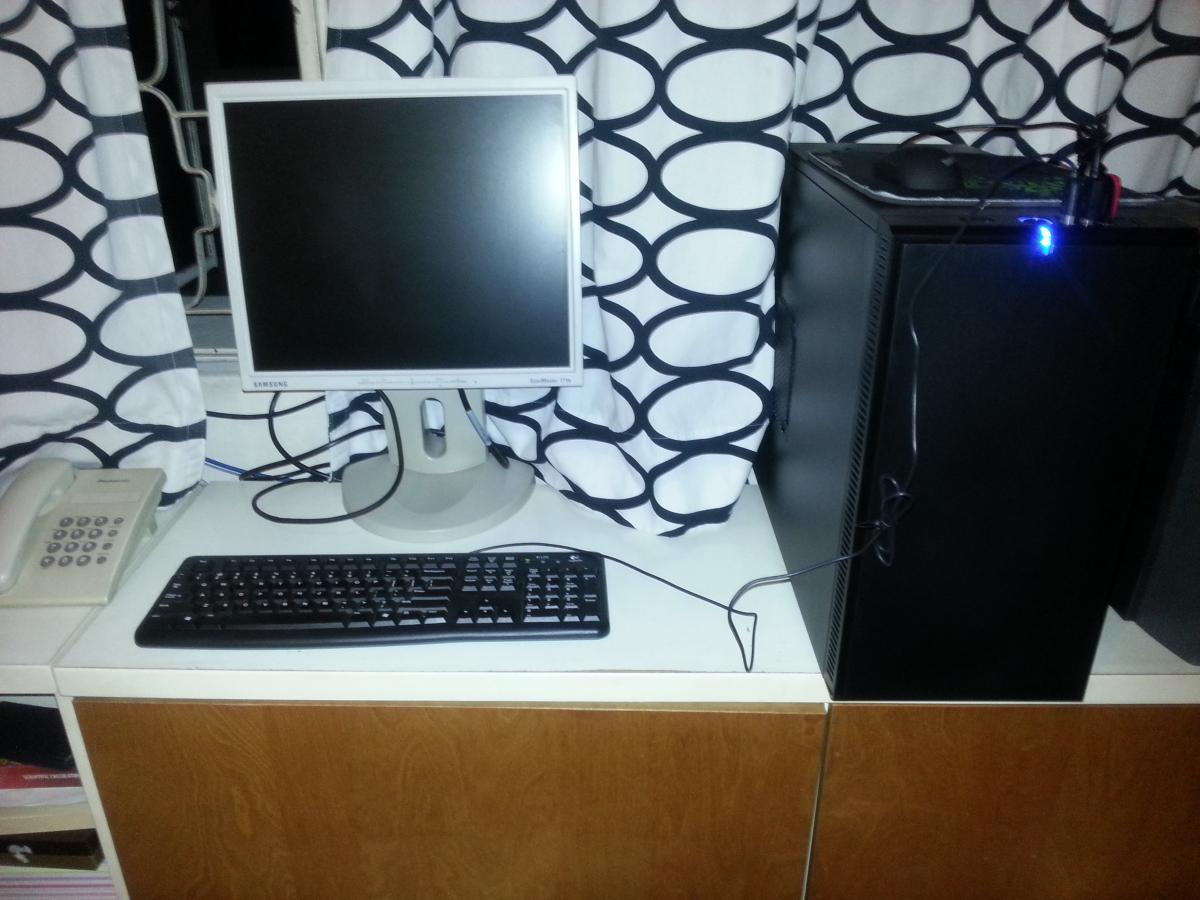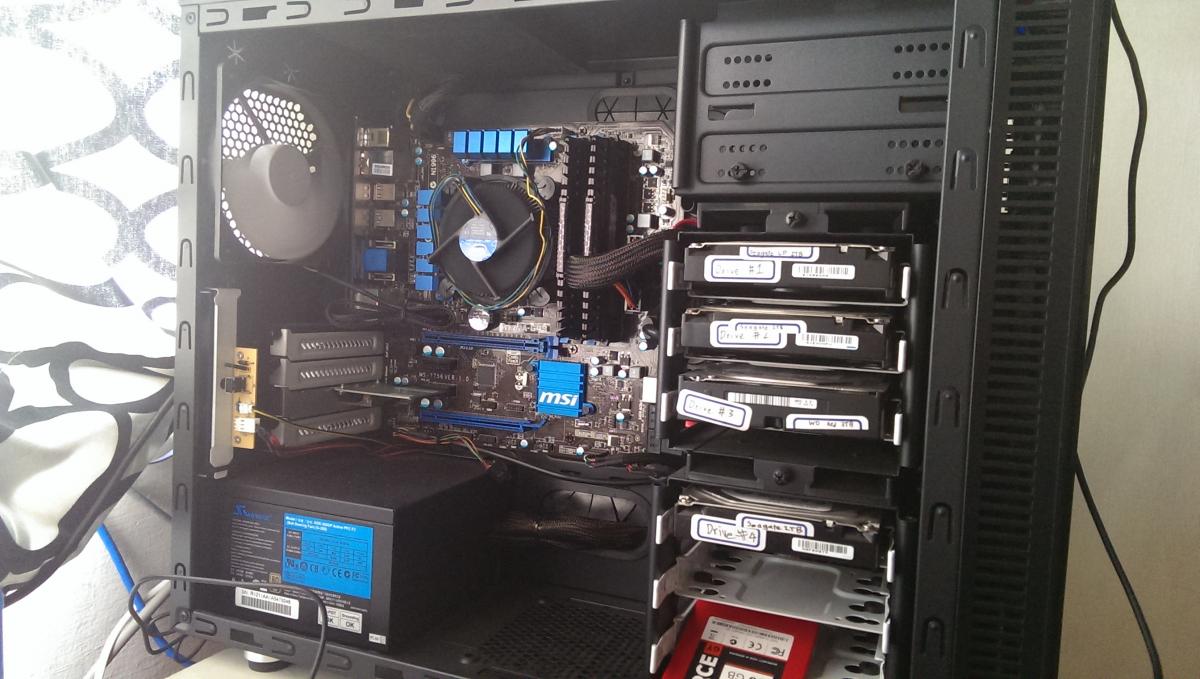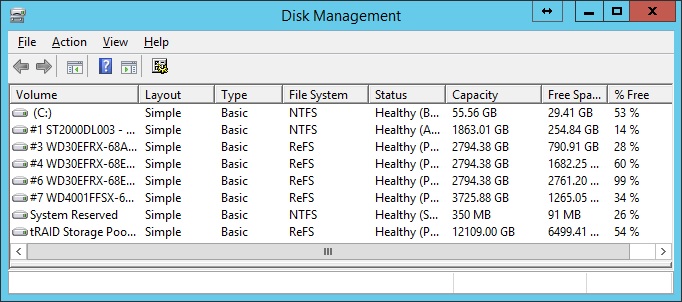-
Posts
220 -
Joined
-
Last visited
tycheleto's Achievements
-
You got it lucky, i think I have a 100% failure rate of the Seagates from a couple of years ago. Somehow the switch to 1TB platters broke their reliability. I still have a 6-7 year Seagate 2TB that refuses to die though. I'm sure over a larger sample size the failure rates aren't as extreme, but it just doesn't seen as low as it should be
-
What are you using for your landing drive? And does it make a significant difference to performance? Wondering if an SSD is necessary or whether I should just repurpose a 1TB WD Black for it
-
Certainly one of my favourite features of SSDs. I believe that photo is a bit outdated though, got more drives now so I think the SSD has been moved to the 5.25" bays. Similarly mounted though. And my Desktop has 3 SSDs also similarly hanging in the 5.25" bays. Keep planning to get proper mounting to show off the SSDs but never have the time or the budget to spend on it.
-
Finally gotten around to posting this, although most of the changes were done months ago. Still in the process of setting up new features since I'm currently serving my military commitment and so can only work on it during the weekend. Got a new 24 port Mikrotik switch so starting to explore more into servers and networking. Original post at: http://linustechtips.com/main/topic/21948-ltt-10tb-storage-show-off-topic/?p=657061 Hardware CASE: Fractal Design Define Mini PSU: Seasonic G-360 MB: MSI H77MA-G43 CPU: Intel Pentium G2020 HS: Stock Intel Heatsink RAM: 8GB DDR3 1600 SSD: Corsair Force GT 60GB SSD HDD 1: 1x 2TB Seagate Barracuda Green ST2000DL003 HDD 2: 3x 3TB WD Red WD30EFRX HDD 3: 2x 4TB WD Red Pro WD4001FFSX Total HDD Capacity: 19 TB Total Usable Capacity: 15 TB Software and Configuration: My server is running Windows Server 2012 R2 Datacenter with FlexRAID Transparent Raid(tRaid) for pooling/array, with the array formatted as ReFS. The array has the three 3TB WD Red Drives and one of the 4TB WD Red Pros as data drives, with the last 4TB WD Red Pro as a parity drive(13TB Usable, 15TB Total). The last 2TB Seagate is an extremely old drive( 46000+ power on hours and counting) still using NTFS and is just used for Misc storage/Backups/iSCSI to boost my main rig's storage The array currently has the one 2TB Seagate drive and two 3TB WD Red as data drives, with the last the 3TB WD Red as a parity drive (8TB Usable, 11TB Total). Usage: Home Server is used for mainly music(~2TB), Videos(~2TB) and Backups (~2TB+). Most computers access the server via SMB/Windows Server shares with no software. Server used to run Emit Free/Air Playit Server for access on Android/iOS, and runs Plex for videos, but I have not installed this since changing to Windows Server, and will see if I need it in the future. It also has Minimserver+Bubbleupnp for music streaming. It handles backup for 4 other Windows Computers, and also acts as a bit of shared storage for documents and pictures. Am learning to configure Windows Active Directory and iSCSI to help manage the shared storage and give the server more purpose. Backup: Currently no backup of entire server. However, most data is replicated in at least one other location to prevent hardware failure from causing data loss. Additional info: Status as of Dec 2013: Server is still fairly unstable even after a few months of experimentation. First tried unRAID for a while, but write performance wasn’t sufficient. Moved to Real Time Raid for FlexRAID, but kept having errors, to the point I was recalculating my entire parity at least once every 2 or 3 days. Moved to tRAID to see if it improves stability, but still a work in progress as tRAID is still in the RC stage. Waiting for tRAID to reach full release before I finalize the software setup. 2014 April Update: Server has been very stable past few months, had a period where it stayed on for 48 days in a row. Transparent RAID is being continuously updated, so getting small performance increases every now and then. Just had a disk failure last week, which made me realize that I had my drive labels wrong, and had to reconfigure the entire array, but should be good now. 2015 March Update: Server had another Seagate drive fail in the past year, which means all except the extremely old 2TB Seagate Barracuda Drives have failed. They just don't seem to be as reliable since they switched to 1TB Platters. As such, have moved to WD Reds/Red Pros, which seem much better for the array. Was having a weird issue where one of the Red Pros kept dropping out of the array, yet it was passing all tests. Hasn't occurred since the switch to Windows Server so will monitor it for a while. Have a 1TB WD Black I might want to add to the server to make it a nice round 20TB, and I'm trying to get a small 60GB or 120GB SSD for a transparent raid landing disk, but haven't found the time to get one yet. Hopefully soon. Photo's:
-
-
The key point is that for a mechanical drive, having a file spread across multiple places means that the drive head has to physically move to various places, taking time and slowing down the file read. As for SSD, accessing files across multiple places are virtually the same in terms of seek time as everything is flash and there are no moving parts. I say virtually the same, there might be a small drop in performance as the data is not completely sequential, but its quite small, and almost negligible. The reason why that benefit is not worth it in any way, is that flash has a limited number of write cycles, and the performance of the drive does degrade as you use up these write cycles. By defragging a drive, you are basically using many write cycles shuffling the data around continuously in order to make the files sequential. This is just destroying the overall life span of the drive, and while you might get a tiny short term benefit, it is definitely not worth it at all.
-
If you want a lightweight premium antivirus you should consider webroot, its great but a bit expensive and seems unnecessary for most people. How you use your computer is usually more important than what antivirus you get.
-
Have an update coming very soon that should move me a bit up the rankings. Had a 3TB die on me(which means all Seagate Drives I purchased 2011 or after have died). Just bought two new 4TB Red Pros to replace it and have a small upgrade too. Moves me from 14TB total to 19TB total(which will be reconfigured to be a 17TB array with 13TB usable, as well as a 2TB drive outside of the array for downloads/misc use). Quite amazed that the 2TB Seagate Drive is still going strong after some 41000+ power on hours. Anyway, will update my post when I finish all the FlexRAID reconfiguration required to change the parity drive and swap the drives around. I'm currently doing Western Digital Data Lifeguard Diagnostics Extended Tests to check the drives before i put them in the array, and wondering if this is really necessary. What do you all do to properly test new drives before use?
-
Thanks for the info. Well, my home server is currently running FlexRAID Transparent RAID on top of Windows 8. It acts as backup for multiple Windows Computer(Just using Windows Backup), serves Music to multiple computers(through iTunes, as well as MinimServer), also serves Video(through default network sharing, as well as BubbleUPnP, and Emit for Android, and Airplayit for iOS). I doubt I'd move to Storage Spaces anytime soon, and when I do decide to upgrade, it would likely be to hardware RAID, or a more storage focused OS. I have also been using it as a web server for a while, with Apache, MySQL and PHP, but I'm trying to move this to another computer to reduce the load/generally better security. The main thing I see in Windows Server 2012 that may interest me is some of the remote access. I currently use Teamviewer and FTP for remote access to the server, but am open to considering other more stable solutions, like setting up a VPN. I'm assuming that Windows Server 2012 is a lot better for setting up a VPN. I think the most I'd ever do with this server is have it to backups and storage for my family at home, and then remote storage/access for friends/family while outside. Not really sure that's enough to make a server OS viable
-
What are the most important differences between the desktop and server versions of windows? I can get a Windows Server License free as a student and move my home server over to that, but I'm not sure if its worth the effort moving everything over.
-
I haven't really tested removing drives on the fly, but in the past few months I've recovered from 2 drive failures. The first failure was a slow failing drive, and I wasn't sure so I shut everything down once it failed, and waited till I got a replacement disk. The second failure I was able to remove the disk and have the rest of the array run fine. Required a restart due to flexraid, but at least I could mostly minimize downtime.
-
A small increase in total capacity by 1TB, cos I had a 2TB Hard Drive fail, and replaced it with a 3TB. Therefore total capacity is now up to 14TB. Also, added another photo. Have updated original post at: http://linustechtips.com/main/topic/21948-ltt-10tb-storage-show-off-topic/?p=657061 Hardware CASE: Fractal Design Define Mini PSU: Seasonic G-360 MB: MSI H77MA-G43 CPU: Intel Pentium G2020 HS: Stock Intel Heatsink RAM: 8GB DDR3 1600 SSD: Corsair Force GT 60GB SSD HDD 1: 1x 2TB Seagate Barracuda Green ST2000DL003 HDD 2: 3x 3TB WD Red WD30EFRX HDD 3: 1x 3TB Seagate Barracuda 7200.14 ST3000DM001 Total HDD Capacity: 14 TB Total Usable Capacity: 11 TB Software and Configuration: My server is running Windows 8 with FlexRAID Transparent Raid(tRaid) for pooling/array. The array currently has the one 2TB Seagate drive and two 3TB WD Red as data drives, with the last the 3TB WD Red as a parity drive (8TB Usable, 11TB Total). The 3TB Seagate is a last drive for downloads/misc files/backups for files I need access to even when array is unavailable. Usage: Home Server is used for mainly music and videos. Server runs Emit Free/Air Playit Server for access on Android/iOS, and runs Plex for videos, a few devices also use the server for iTunes Libraries. Most computers access the server via SMB with no software. The server also enables a centralized place for downloading programs/videos for everyone's access. It’s also for backing up my computers. Backup: Currently no backup of entire server. However, most data is replicated in at least one other location to prevent hardware failure from causing data loss. Additional info: Status as of Dec 2013: Server is still fairly unstable even after a few months of experimentation. First tried unRAID for a while, but write performance wasn’t sufficient. Moved to Real Time Raid for FlexRAID, but kept having errors, to the point I was recalculating my entire parity at least once every 2 or 3 days. Moved to tRAID to see if it improves stability, but still a work in progress as tRAID is still in the RC stage. Waiting for tRAID to reach full release before I finalize the software setup. 2014 April Update: Server has been very stable past few months, had a period where it stayed on for 48 days in a row. Transparent RAID is being continuously updated, so getting small performance increases every now and then. Just had a disk failure last week, which made me realize that I had my drive labels wrong, and had to reconfigure the entire array, but should be good now. Photo's:
-
Instant heart rate actually has quite a few good reviews claiming it's accurate. And it seems reasonably accurate from experience too.
-

Plan for cheap home server using mixed drives
tycheleto replied to dochesterton's topic in Storage Devices
+1 on the FlexRAID recommendation. With FlexRAID you have a lot of freedom with regards to how you setup your drives, and you can merge them to be a single unit if you prefer, or you can leave them individually, and organize your files yourself based on the drives. Depending on the version of FlexRAID you buy, you could also just pool everything into one entire pool, where it emulates a RAID 5 array in the sense that you see them as a single disk, and you are protected from a single drive failure, but you are less likely to have software errors and the restrictions placed on Hardware RAID. One thing to note is that FlexRAID performance is not that great, the reads should be similar in speed to the source drive, but the writes are nowhere near as fast due to the calculations required, and this could be a problem if you're writing very heavily. Also, there is now a new variant of FlexRAID called Transparent RAID, which does the parity calculations in real time similar to RAID 5, and seems a lot more user friendly than the original FlexRAID. The software might be around $100, but compared to the cost of a RAID Controller and new drives, it's a pretty good deal if it suits your needs -
A lot of things. My HAF 912 has a dead USB 3.0 port, and has insufficent room for cable management I cannot enter the BIOS on boot for some reason, so I cannot set permanent overclocks, and cannot fix the fan profiles, so I manually set my fan profile after every boot. My WD Black makes loud noises when in use, though this I can live with. It randomly hangs every day or two where I think the graphics is unresponsive, no idea how to diagnose the problem since it just happens out of nowhere.










